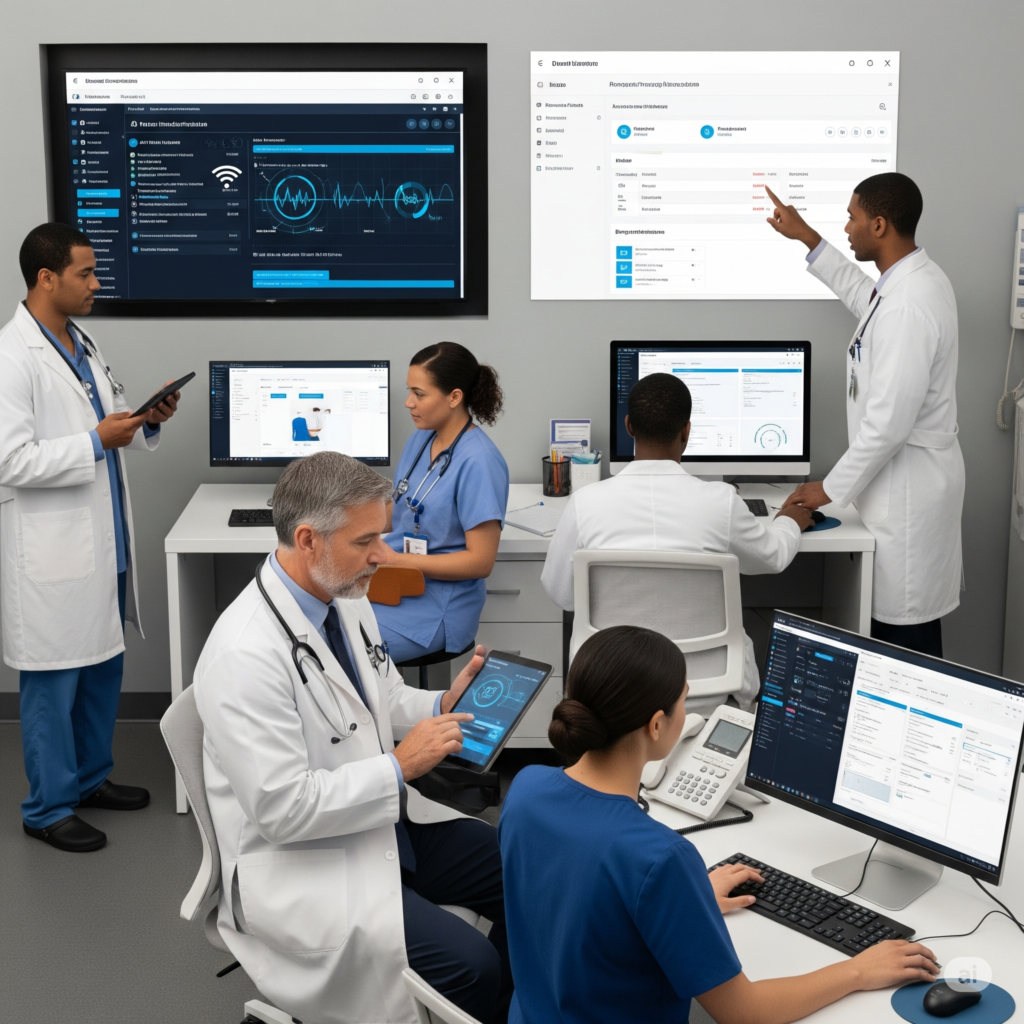
Clinicians, administrators, and hospital owners face unmanageable administrative burdens, frequent errors, and mounting burnout. According to the 2024 Medscape–AMA report, 62% of physicians identify bureaucratic tasks, like charting and paperwork, as the primary factor. However, clinical efficiency, redefined through intelligent workflow automation, is significantly reducing clerical overload and streamlining patient communication. As a result, AI-powered workflow automation tools are proving to be truly transformative. In a recent case study, automation saved 15,000 employee hours per month and delivered a 30% ROI for healthcare clients. As the need for streamlined, technology-driven care intensifies, Hue Logics – Okta Health is emerging as the preferred choice for seamless integration and scalable results in today’s evolving care environment.
What is Clinical Efficiency & Workflow Automation?
- Clinical efficiency is delivering high-quality care within the right time, resources, and clinical expertise in the most effective way possible. The clinical efficiency definition emphasizes not just speed, but also accuracy, reduced errors, and improved patient outcomes.
- The workflow automation’s meaning lies in its ability to streamline routine tasks, such as alerts, documentation, and communication through intelligent tools and systems, allowing clinicians to focus more on patient care and less on administrative overhead.
The Pain Point
Poor Clinical efficiency inefficiencies translate to:
- Lost clinician hours on paperwork: Clinicians lose valuable hours to paperwork and documentation, significantly reducing the time available for direct patient care and critical thinking.
- Delayed interventions and suboptimal care delivery: Delayed interventions caused by fragmented systems and manual workflows can lead to missed warning signs and poorer health outcomes.
- Staff burnout and turnover: The constant administrative pressure contributes heavily to staff burnout and turnover, affecting team morale and continuity of care.
How to Improve Clinical Efficiency & Examples That Matter
Real-world Workflow Automation Examples:
Healthcare teams struggling with repetitive tasks like manual charting or coordination thrive when implementing workflow automation tools:
- Remote Therapeutic Monitoring (RTM) alerts that prompt early intervention.
- Pre-populated progress notes for quicker documentation.
- Automated patient reminders for better adherence.
- AI-powered triage bots to filter low-risk cases.
Key Drivers of Change in Healthcare Workflows
- Document workflow automation: Eliminates tedious forms and frees up clinician time.
- Customer Relationship Management (CRM) automation: Ensures follow-ups and referrals are logged seamlessly.
- Training and adoption: To support staff in embracing automated processes.
Spotlight – Hue Logics’ Okta Health: Designed Around Clinician Needs
Why Hue Logics Built Okta Health?
Hue Logics understands the daily frustrations clinicians face: endless documentation, siloed systems, and delayed care. Built to centre clinical efficiency, Okta Health offers:
- Smart Remote Monitoring (RTM): To automate patient data collection.
- Real-time prioritization: Using AI, cutting through the noise.
- Integrated care workflows: No more juggling apps or rampant copy-paste.
- Pre-built documentation tools: Significantly reduce manual input.
By weaving workflow automation into every module, Okta Health becomes more than software; it’s a transformation engine.
Competitive Edge: How Okta Health Stands Out?
| Feature Area | Okta Health by Hue Logics | Common Alternatives |
| RTM + Smart Alerts | Built-in and seamlessly integrated | Often requires separate modules |
| AI-Enhanced Support | Advanced Home Exercise Program (HEP) creator with intelligent suggestions | Primarily static or manual HEP tools |
| CRM Workflow | Inherent follow-up and tracking | Siloed, manual CRM link-ups |
| Ease of Adoption | Intuitive UX with minimal training | Steep learning curve, discontinuity |
| Scalability | Cloud-enabled, global rollout | On-premises or limited deployment |
Okta Health’s unified platform contrasts sharply with fragmented tools that require extensive integration or manual upkeep.
The Road Ahead: Future of Workflow Automation in Healthcare
Emerging Trends to Watch
- AI Workflow Automation: Deeper decision-support capabilities and predictive analytics.
- Telehealth & RTM synergy: Continuous real-time health monitoring.
- Supercharged CRM workflows: Continuous data flow and automated follow-up.
- Workflow automation free trials: Become more common, try before you buy.
Quick Tips – Boost Clinical Efficiency Today
- Audit existing workflows and identify manual pain points.
- Start with simple workflow automation examples like template notes or reminders.
- Evaluate platforms offering RTM + triage + CRM—Okta Health checks all these boxes.
- Run small pilots, gather clinician feedback, and refine workflows.
Conclusion
By placing clinical efficiency and workflow automation at the core of care delivery, healthcare organizations can unlock a wide range of transformative benefits including improved patient outcomes, reduced clinician burnout, enhanced staff engagement, and stronger operational performance. Hue Logics – Okta Health delivers precisely that: an AI-powered platform designed to streamline workflows, optimize documentation, and support clinical decision-making, all within a scalable, clinician-focused ecosystem.
Ready to elevate your care delivery? Connect with Hue Logics today to explore how Okta Health can empower your team and schedule a personalized demo to see it in action.
Frequently Asked Questions (FAQs)
Q1: What is workflow automation in healthcare?
It refers to the use of software, AI, and digital tools to automate routine clinical and administrative processes reducing human error, time, and cost.
Q2: How does workflow automation help CRM in hospitals?
By integrating follow-up reminders, referral tracking, and patient feedback into workflows automatically ensuring no patient “falls through the cracks.”
Q3: Are there good workflow automation tools that are free?
Some tools offer freemium tiers (e.g., basic reminder systems), but enterprise-level workflow automation software with features like RTM and AI triage typically comes at a cost like Okta Health’s commercially robust suite.
Q4: What are examples of workflow automation in clinics?
Common examples include auto-generated progress notes, patient reminders, intelligent triage, RTM data collection, and CRM-driven follow-ups.
Q5: What is the meaning of clinical efficiency?
It’s the ability to deliver high-quality care using optimal time and resources minimizing waste, maximizing outcomes.
